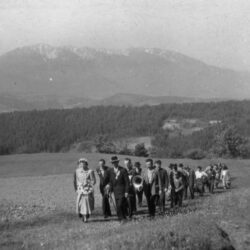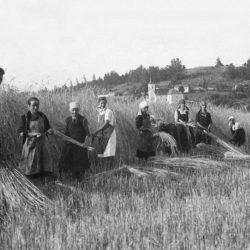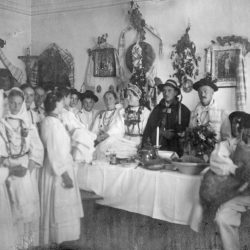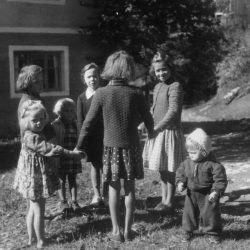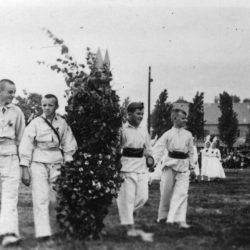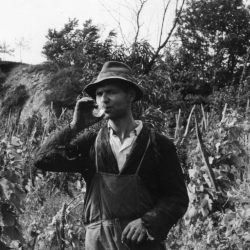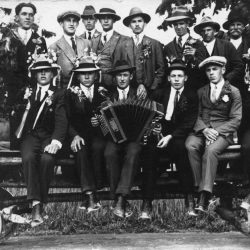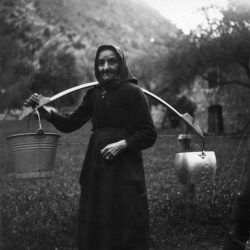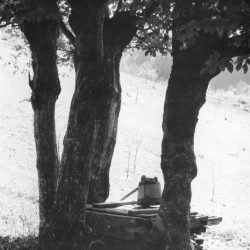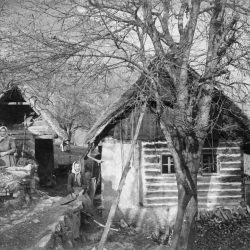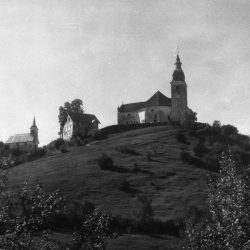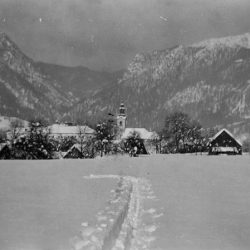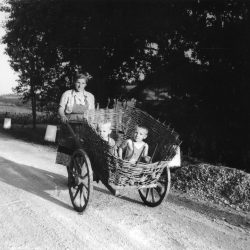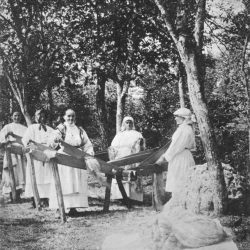Songs of Slovenia
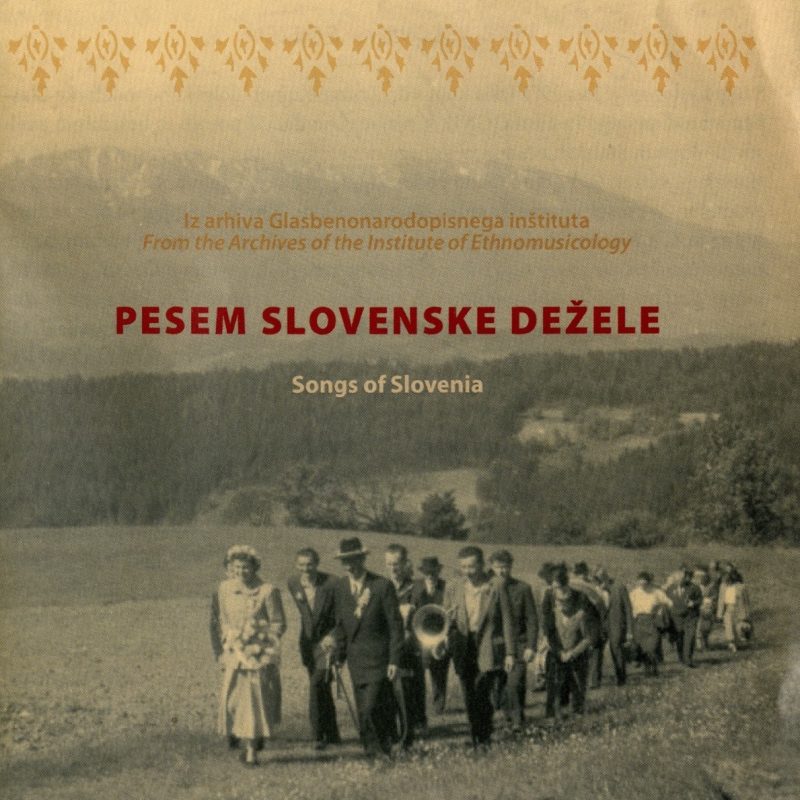
PSD 1, str. 149; GNI M 24.024
Recorded: Jakov Dol, Styria, 1962
Sung by: Ivan Kapus (1927), Milan Kapus (1914), Rado Kapus (1923)
When singing by groups of young men was still a living tradition in Slovenia, this was the first song of the evening in Jakov Dol, where it became the singers’ unofficial anthem. This version from Jakov Dol has obviously lost its melancholy conclusion about the end of love, judging from similar versions from other parts of Slovenia. This song is sung in the typical folk manner of male three-part singing. At the end of each stanza the top voice moves higher, hinting at the singing style called petje na tretko, which involves additional harmonizing by a fourth, higher voice.
PSD 7, str. 155; GNI M 23.194
Recorded: Podkoren, Upper Carniola, 1959
Sung by: Emil Razinger, Franc Razinger, Lojze Razinger, Anton Mertl, Anton Berce
This two-stanza love song, in which the verses also repeat, cannot communicate any deep meaning of course, but is simply the brief impression of the happiness of a boy that is loved by a girl that will continue to love him. Of greater interest is the male (Upper Carniolan) part-singing in this brief song, featuring singers from Podkoren. The song is sung in four-part folk style; this was once found across most of Slovenian ethnic territory, but is rarely heard today. The musical structure of folk part-singing differs from choral part-singing because two voices are sung above the lead voice. The third voice above the bass part, known as na tretko in Slovenian, characteristically remains on one or two notes.
PSD 59, str. 205; GNI M 24.214
Recorded: Žižki, Prekmurje, 1961
Sung by: Matija Koštric (1897)
It is somewhat unusual for a love song to involve as much narrative as this one. This is primarily due to the repeating verses, in which the girl asks in each verse what the boy will bring her. Among the many village serenaders, the girl recognizes her suitor by his gift because only he brings her a plait of rosemary, a symbol of their fidelity and affection. All of the other serenaders – who bring a kerchief, an apron, clothing, shoes, earrings, or a bracelet – are rejected by the girl, who nonetheless does not refuse the gifts.
PSD 42, str. 189; GNI M 26.867
Recorded: Šentanel, Carinthia, 1964
Sung by: A group of locals led by M. Šipek
This brief love song repeats the generally held idea that love is beautiful and often makes one’s head hurt. The verse structure of the song is comprised of eight- and seven-syllable distiches, which is a common verse and metrical pattern in Slovenian folk love songs (e.g., Snoč pa dav je slanca padla / na zelene travnike ‘Tonight the frost descended / On the green meadow’). This verse form is also known as the “pilgrimage verse” in Slovenian and was borrowed from the Germans in the nineteenth century. It first appeared in Styria, especially in translated songs, then also in folk songs, and then this verse form more or less spread throughout all of Slovenia. Songs with this verse pattern are generally considered relatively recent. Five-part singing is extremely rare today; in the second half of the twentieth century it could still be heard in the Savinja Valley and in Carinthia, where this example comes from. The softness of the singers’ voices is reminiscent of choral singing.
PSD 95, str. 237; GNI M 23.554
Recorded: Zgornji Tuhinj, Upper Carniola, 1960
Sung by: Franc Zore (1891)
Village serenaders once had their own special songs or verses that were recited instead of sung to call to a girl. These were only intended to catch the girl’s attention. In Upper Carniolia these types of verses were called kozje molitvice or ‘goat prayers.’ They were not friendly forms of address, but jesting or even mean-spirited when the girls were too choosy or did not welcome serenading. The boys later “selected” such girls for these goat prayers. Because of their local and personal elements, these were quite idiosyncratic and particular, so similar versions of these compositions did not spread widely throughout Slovenia.
PSD 148, str. 281; GNI M 26.882
Recorded: Dolga Brda, Carinthia, 1964
Sung by: The Piko family
Even in the nineteenth century, much of Bishop Anton Martin Slomšek’s poetic opus had made its way into folk singers’ repertoire, including this example. However, Slomšek’s poem did not originally refer to a wedding, but to a frame of mind and upbringing, like the majority of his poems. Because it mentions bell-ringing for matins, singers in Carinthia began to sing it for couples the morning after the wedding. This changed the original function of Slomšek’s poem to a wedding ritual. The song is sung by a mixed group in six parts, and in places the voices also divide into seven parts. The singers did not remember the last two stanzas of the song well and sang them with uncertainty; in addition, this part of the recording contains significant technical imperfections. Because of this, these two stanzas are not included on this CD.
PSD 165, str. 294; GNI M 27.670
Recorded: Bila / S. Giorgio, Resia Valley, 1966
Sung by: Marija Paletti, Giuliana Najda
Devotional songs by known composers are generally not part of the repertoire of folk singers, but are preserved only by those that created the songs themselves and were not sung in church. In the Resia Valley the majority of devotional songs, except for a few apocryphal prayers, were also sung in church. Very little is known about who composed them. They were generally created by talented individual singers. Resians sang the song “Blessed Mother, Intercede for Me” while performing the Stations of the Cross.
PSD 184, str. 311; GNI M 23.242
Recorded: Kopriva, Littoral, 1959
Recited by: Danila Mercina (1946)
Among the many counting rhymes for children’s games published to date, the fewest have come from western Slovenia. We thus decided to include this one from the Karst region.
PSD 213, str. 325; GNI M 31.702
Recorded: Andovci / Orfalu, Rába Valley, 1970
Sung by: Marija Mešič (1899)
This song is known in various versions throughout Slovenia, only that the questions and answers change somewhat, they involve different objects and animals, and they may also end somewhat differently. This version from the Rába Valley is closest to certain Prekmurje versions, but differs in many ways from other Slovenian versions. Even its beginning is different because the first verse (“Old woman, old man”) is known elsewhere in Slovenia from other children’s songs or even from humorous songs.
PSD 518, str. 610; GNI M 22.615
Recorded: Kapela, Styria, 1958
Sung by: A schoolgirl
For a few years after the Second World War, children throughout the Slovenian countryside went from house to house on the Feast of Holy Innocents to ritually thrash people. They “tapped” adults with their switches while reciting (in some places, singing) a few verses about the thrashing ritual; the second part of the song expressed good wishes. Ritual thrashing is part of winter (Christmas and New Year’s) caroling, and so the children expressed good wishes for the coming year, good fortune for the home, people, and animals, and no hardships (or as few as possible). The adults at each house would give the visiting children food or money.
PSD 224, str. 333; GNI M 25.123
Recorded: Črešnjice pri Cerkljah, Lower Carniola, 1962
Sung by: A group of men
Today Saint George’s Day and carols for that day are primarily associated with White Carniola, but Saint George’s Day caroling once took place throughout Slovenia. In some places this custom has completely died out, and in others it has changed – for example, in Lower Carniola, where boys brought greenery to their girlfriends on Saint George’s eve (23 April). “Unworthy” girls (i.e., annoying or unfriendly ones) received only thorns. This custom is of course more recent and no longer has any connection with traditional Saint George’s Day caroling. The diction and content of this song, which was still sung in Črešnjice in the 1970s, show that this is also a more recent song.
PSD 249, str. 356; GNI M 25.580
Recorded: Zagorica (Dobrepolje), Lower Carniola, 1963
Sung by: Ančka Lazar (1927)
The wooden-shingled and straw-thatched houses still found among poorer and tenant farmers in the Slovenian countryside before the Second World War represented a constant danger of fire. Some villages and market towns therefore retained professional night watchmen, who would sing out on the hour or add some kind of verse in honor of Saint Florian, who protected against fires. The residents were thus always aware of what time it was and the watchman’s singing also proved that he had not fallen asleep. Although watchmen stopped singing well before the Second World War, their calls and songs long remained in people’s memories. For every hour that they announced, the night watchmen also had a kind of sung “message” with some verse. These short songs may have had a devotional or moralizing nature, or may have been more humorous and local in character, as is this example of a night watchman’s song from Zagorica in Lower Carniola.
PSD 264, str. 368; GNI M 23.674
Recorded: Jastroblje v Tuhinjski dolini, Upper Carniola, 1960
Sung by: A group of locals
This song most likely originated in Styria, from which its first transcriptions, dating from the 1830s, are also known. It was transcribed at that time by Stanko Vraz in his native village, now known as Cerovec Stanka Vraza. Karel Štrekelj’s folksong collection indicates that versions of this song were also transcribed in the nineteenth century in Carniola (including White Carniola) and the Littoral. This song about four types of wine (and prices) and those that drink them is still a favorite today.
PSD 268, str. 373; GNI M 30.066
Recorded: Velika Varnica, Styria, 1969
Sung by: A group of locals
Although this song is similar to versions that Štrekelj published in his collection and titled “Genealogija vina” (The Genealogy of Wine), this version from the Haloze Hills has a different focus. In contrast to Štrekelj’s versions, this version emphasizes how wine is made and the work involved. It is therefore not surprising that this was also a work song that accompanied various forms of labor in the Haloze vineyards. It is interesting that a similar version was recorded in the Savinja Valley. We chose to present the Haloze version due to the special sound of folk singing there.
PSD 287, str. 390; GNI M 21.086
Recorded: Viševek, Inner Carniola, 1957
Sung by: Franc Plos (1912)
Slovenian folk song does not include many martial or heroic songs, or songs that glorify the army and military service. Instead, these are more melancholy than bellicose, and refer more to the senselessness of warfare and young men’s difficult farewells from home and loved ones. Young Slovenian men were not enthusiastic when universal military service lasting several years was introduced in 1763. It is no wonder that many rural youths sought to avoid military service and went into hiding or became outlaws. For many of them, this was also not a solution because many could not bear continuous hiding and its strenuous lifestyle, and they broke under the stress, as this song describes.
PSD 304, str. 405; GNI M 25.382
Recorded: Solbica / Stolvizza, Resia Valley, 1962
Sung by: A group of women, led by Irma Buttolo (1929)
Most Resian songs, including love songs, are connected with nature, or individual songs are merely brief impressions with a splendid metaphor and short but pithy thought. Some like to compare Resian lyric verse with ancient Chinese or Japanese verse because of its concise and impressionistic nature. This “similarity” is likely only in the elementary feeling for nature and each small living element in it, even if the singer only wishes to convey what he saw when he climbed Mount Chila and how happy he was when a girl in Uccea waved to him, which this song also describes. With regard to the style of singing, this song is interesting because of its underlying low tone or drone style of creating a part song. The syllabic refrain at the end of each stanza is characteristic of Resian folk song.
PSD 317, str. 416; GNI M 22.728
Sung by: Križ, Upper Carniola, 1958
Sung by: Kovačeva Micka (1888)
Only four versions of this song have been found to date. Three were published by Štrekelj and one was recorded by Institute of Ethnomusicology associates in 1958. The song appears to have originated in Smlednik or nearby. According to the singers, it was composed at the beginning of the twentieth century by a farmer from Smlednik named Janček. The song is said to have an authentic background in that the girls in Smlednik used to go mushroom hunting and then sell them at the Ljubljana market. In terms of content, the song could conclude after five stanzas; however, it has an additional five stanzas that are very heterogeneous in content and no longer belong to the song. The reason for this is the song’s traditional alpine quatrain structure: short four- to six-syllable verses that tell a complete story. Because this story about unlucky or deceptive mushroom hunters was composed in alpine quatrains, sometimes additional quatrains with different content were spontaneously added to them.
PSD 326, str. 425; GNI M 27.781
Recorded: Osluševci, Styria, 1965
Sung by: Marjan Korpar (1933)
Slovenian folk songs about various professions or trades and craftsmen often have a sort of double nature: on the one hand, the trade is vitally necessary, but on the other hand the craftsmen are unwanted because they are always too expensive. The songs that were created by the craftsmen themselves or in their guilds generally glorify a particular profession or describe the difficulty of the work; they are also often humorous. Singers were happy to sing something about a particular profession for a glass of wine. This song features the cartwright, who was indispensable to the farmer. The song therefore ends with the observation kolár naj pije, köjko če, / kölko mo v želodec gre (A cartwright may drink as much as he will / As much as his stomach can hold).
PSD 334, str. 432; GNI M 26.754
Recorded: Zilje, White Carniola, 1957
Sung by: A group of men
Although this recording contains technical imperfections, we nonetheless included it in this collection because prisoners’ songs are so rarely encountered in folk music. This is especially so for songs such as this, which were created in the past but are still sung today.
PSD 357, str. 453; GNI M 33.980
Recorded: Verice-Ritkarovci / Kétvölgy, Rába Valley, 1972
Sung by: Margit Gáspár (1951)
In addition to heroic, historical, fantastic, social, and other themes, ballads also include songs that feature animals with human qualities. This song from the Rába Valley contains the familiar theme of a love-smitten blackbird. It actually has two thematic parts: the first contains a theme about hunters that would like to shoot the blackbird. In the versions of this song the blackbird always evades the hunters, and these songs end here; one can therefore speak of a special theme in which the blackbird ridicules the hunter. The second theme present in this song is the love-smitten blackbird and his loves. The version presented here combines both themes into one song. The pentatonic melody, which is also frequent in songs from this area, is evidence of the older origin of this song. At the same time, the semitone indicates a transition to a diatonic melody.
PSD 470, str. 561; GNI M 23.505
Recorded: Zgornji Tuhinj, Upper Carniola, 1960
Sung by: Jože Jeglič (1909)
Only Vraz’s transcription of this song about the sudden death of three daughters appears in the first volume of Štrekelj’s collection. This song, including the twentieth-century version presented here, is essentially moralistic because it observes that death awaits all, also affecting the rich – in this case, an innkeeper that shows no mercy to a female traveler (Death) and does not want to offer her lodging, and therefore loses all three of her daughters. The song has a somewhat emphasized social aspect, repeating the standard theme of greedy innkeepers, whose wealthy haughtiness and confidence is destroyed only through divine punishment. In the Tuhinj Valley, where this song was recorded, it was also sung during wakes because of its death theme.
PSD 414, str. 511, GNI M 31.984
Recorded: Obirsko / Ebriach, Carinthia, 1969
Sung by: Valentin Polanšek, Justina Polanšek, Valentin Mak, Johan Brumnik, Franc Brumnik, Karl Haderlap, Matija Karničar, Silvester Karničar
This song is also a contamination of two ballads with themes of love. In the first part, the song is merely a variation of a well-known ballad about fidelity to a lover that faithfully waits for years for her young man to return from military service. However, the second part is a ballad about a girl that prefers her brother to her lover and therefore must die. The song is sung in alternation between an individual and the group. The first verse is always sung solo in free rhythm, and then the other folk singers join in to create four-part harmony.
PSD 163, str. 292; GNI M 23.036
Recorded: Vrba, Upper Carniola, 1959
Sung by: Anton Mulej, Malka Tavčar, Vinko Zupan
This song in this form seems somewhat joking with its gallows humor. However, it shows how a once tragic ballad about sentencing two foreigners to death can be transformed into an entirely different song. This often happens with old ballads that were created immediately based on some actual event (in this case, the hanging of two Italians at Friškovec Field, which used to serve as Ljubljana’s place of execution). Then, when the event was forgotten, the song could be transformed into another, shortened, or even forgotten. This version also no longer has a true ballad structure because its function has become only that of a humorous song with certain elements of other humorous songs.
PSD 407, str. 504; GNI M 24.832
Recorded: Češnjice (nad Blagovico), Upper Carniola, 1961
Sung by: A group of men
This song was once known throughout all German territory because it was also created there in the sixteenth century. It came to Slovenia in the seventeenth or perhaps eighteenth century, receiving certain Slovenian features and changes. It is characteristic of all borrowed songs in that they are adapted to their new environment and singing tastes with regard to locale, mentality, content, and musical character. This ballad was such a favorite of Slovenian singers that over one hundred versions have been collected since it was first transcribed in Slovenia in the nineteenth century. In nearly every version, two solo singers alternate in singing the first two verses, and then the rest of the singers join in to repeat both verses.
Marko Terseglav: Songs of Slovenia
Songs of Slovenia (Pesem slovenske dežele, PSD) was the title of a 1976 book by Zmaga Kumer, an Institute of Ethnomusicology associate for many years. It included the music and lyrics of 537 Slovenian folk songs from all across Slovenian ethnic territory. The two records that accompanied the book contained recordings of twenty-five songs and offered readers the opportunity to hear folk singing. Issuing records with books was a novelty at that time. As the author wrote in the introduction, the sheet music alone “should be as precise as possible, but cannot fully convey the living feeling of a song. This book is therefore accompanied by two discs of documentary recordings from the Institute of Ethnomusicology archive as audio illustrations of the examples.” Although Zmaga Kumer is unfortunately no longer with us, the Institute of Ethnomusicology is preparing a new CD of sound recordings from her book this year, which would have marked the eighty-fifth birthday of this great scholar.
The initial plan was for the CD to include the same selection of songs that Kumer prepared in 1976. However, because the CD will not merely be an audio companion to the book, but will also be listened to by people that do not have the original recordings, it seemed more appropriate to present some new songs selected from the ones Kumer included in her book. It should also be pointed out that many of the songs released on the two records were also released later on other audio recordings. Aside from the new selections, in all other matters Kumer’s concept was followed as presented in the introduction to her book. She wrote that the selection of songs for the records “was determined by a number of factors: they should be representative of all parts of the collection and all Slovenian regions as much as possible, they should present various styles of singing, both the lyrics and the music of the songs should be interesting, and they should present at least some of the singers mentioned in the introduction to the book. Of course, not all of these demands can be satisfied; limited space meant that entire examples could not always be recorded onto the disc. A list is therefore provided with the song number as it appears in the collection and the page where it can be found in the book”.
The selection of songs for this CD followed all of these wishes, as well as Kumer’s division by content and chapter in the book, with the distinction that it presents complete versions of the songs. We also numbered the songs and added the page number where the song appears in the book (e.g., PSD 1, p. 149). The source or shelf mark under which the song is kept at the Institute of Ethnomusicology is also given, as well as basic information about the place and time of recording and the performers. The songs are accompanied by a brief commentary on the texts and music. We omitted a glossary of less-known, primarily dialect words.
As for every CD released by the Institute of Ethnomusicology, it is necessary to emphasize that these are documentary archival recordings that are not technically perfect. This is especially apparent on this CD, which mostly contains very old recordings. Because of the modest recording equipment at that time, the technical quality of certain recordings is poor. Modern technology has made it possible to restore these recordings and somewhat ameliorate their technical shortcomings, but it must be emphasized that this has not changed the recordings’ content and original sound quality. This material is a priceless document of Slovenia’s intangible heritage, which is also increasingly dying out in Slovenia due to globalization and changing lifestyle, making these documentary recordings all the more valuable. They are presented to listeners in the year that we commemorate the eighty-fifth anniversary of the birth of Zmaga Kumer, who in her more than forty years of work saved much priceless Slovenian folk song from oblivion. Some of the recordings presented on this CD are also the fruit of her many years of fieldwork and research.
